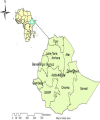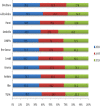Trends and Spatio-temporal variation of female genital mutilation among reproductive-age women in Ethiopia: a Spatio-temporal and multivariate decomposition analysis of Ethiopian demographic and health surveys
- PMID: 32493430
- PMCID: PMC7271420
- DOI: 10.1186/s12889-020-08882-4
Trends and Spatio-temporal variation of female genital mutilation among reproductive-age women in Ethiopia: a Spatio-temporal and multivariate decomposition analysis of Ethiopian demographic and health surveys
Abstract
Background: Female genital mutilation (FGM) is a serious health problem globally with various health, social and psychological consequences for women. In Ethiopia, the prevalence of female genital mutilation varied across different regions of the country. Therefore, this study aimed to investigate the trend and determinants of female genital mutilation among reproductive-age women over time.
Methods: A secondary data analysis was done using 2000, 2005, and 2016 Demographic Health Surveys (DHSs) of Ethiopia. A total weighted sample of 36,685 reproductive-age women was included for analysis from these three EDHS Surveys. Logit based multivariate decomposition analysis was employed for identifying factors contributing to the decrease in FGM over time. The Bernoulli model was fitted using spatial scan statistics version 9.6 to identify hotspot areas of FGM, and ArcGIS version 10.6 was applied to explore the spatial distribution FGM across the country.
Results: The trends of FGM practice has been decreased from 79.9% in 2000 to 70.4% in 2016 with an annual reduction rate of 0.8%. The multivariate decomposition analysis revealed that about 95% of the overall decrease in FGM practice from 2000 to 2016 was due to the difference in the effects of women's characteristics between the surveys. The difference in the effects of residence, religion, occupation, education, and media exposure were significant predictors that contributed to the decrease in FGM over time. The spatial distribution of FGM showed variation across the country. The SaTScan analysis identified significant hotspot areas of FGM in Somali, Harari, and Afar regions consistently over the three surveys.
Conclusion: Female genital mutilation practice has shown a remarkable decrease over time in Ethiopia. Public health programs targeting rural, non-educated, unemployed, and those women with no access to media would be helpful to maintain the decreasing trend of FGM practice. The significant Spatio-temporal clustering of FGM was observed across regions in Ethiopia. Public health interventions must target the identified clusters as well.
Keywords: Ethiopia; female genital mutilation; multivariate decomposition analysis; spatial analysis.
Conflict of interest statement
Authors declare that they have no conflict of interest.
Figures









Similar articles
-
Decomposition and Spatio-temporal analysis of health care access challenges among reproductive age women in Ethiopia, 2005-2016.BMC Health Serv Res. 2020 Aug 17;20(1):760. doi: 10.1186/s12913-020-05639-y. BMC Health Serv Res. 2020. PMID: 32807148 Free PMC article.
-
Geographic Variation and Factors Associated with Female Genital Mutilation among Reproductive Age Women in Ethiopia: A National Population Based Survey.PLoS One. 2016 Jan 7;11(1):e0145329. doi: 10.1371/journal.pone.0145329. eCollection 2016. PLoS One. 2016. PMID: 26741488 Free PMC article.
-
Changing prevalence and factors associated with female genital mutilation in Ethiopia: Data from the 2000, 2005 and 2016 national demographic health surveys.PLoS One. 2020 Sep 3;15(9):e0238495. doi: 10.1371/journal.pone.0238495. eCollection 2020. PLoS One. 2020. PMID: 32881931 Free PMC article.
-
Prevalence of female genital mutilation and associated factors among women and girls in Africa: a systematic review and meta-analysis.Syst Rev. 2024 Jan 12;13(1):26. doi: 10.1186/s13643-023-02428-6. Syst Rev. 2024. PMID: 38217004 Free PMC article.
-
What is currently known about female genital mutilation and incontinence: a narrative literature review.J Obstet Gynaecol. 2025 Dec;45(1):2508980. doi: 10.1080/01443615.2025.2508980. Epub 2025 May 31. J Obstet Gynaecol. 2025. PMID: 40449016 Review.
Cited by
-
Spatial variation of HIV testing and associated factors among pregnant women: a Spatial and multilevel analysis, DHS of sub-Saharan African countries.BMC Public Health. 2025 Apr 12;25(1):1375. doi: 10.1186/s12889-025-22614-6. BMC Public Health. 2025. PMID: 40221705 Free PMC article.
-
Incomplete basic vaccination and associated factors among children aged 12-23 months in resource-limited countries: a spatial and multilevel regression analysis of recent DHS data from 48 countries.Front Public Health. 2025 Apr 14;13:1463303. doi: 10.3389/fpubh.2025.1463303. eCollection 2025. Front Public Health. 2025. PMID: 40297029 Free PMC article.
-
Does previous circumcision and wealth index influence women's attitude to discontinue the practice of female genital mutilation and cutting (FGM/C) in Ethiopia?PLoS One. 2022 Aug 19;17(8):e0272934. doi: 10.1371/journal.pone.0272934. eCollection 2022. PLoS One. 2022. PMID: 35984786 Free PMC article.
-
Spatial distribution and associated factors of co-occurrence of overweight/obesity and Anemia among women in the reproductive age in sub-Saharan Africa: A multilevel analysis, DHS 2016-2021.PLoS One. 2024 Apr 18;19(4):e0299519. doi: 10.1371/journal.pone.0299519. eCollection 2024. PLoS One. 2024. PMID: 38635643 Free PMC article.
References
-
- Rahman A, Toubia N. Female genital mutilation: a practical guide to worldwide laws & policies: zed books. 2000.
-
- UNICEF. Female genital mutilation/cutting: a global concern. 2016 [http://www. unicef.org/media/files/FGMC_2016_brochure_final_ UNICEF_SPREAD. pdf]. Accessed; 2016.
-
- Toubia N. Female circumcision as a public health issue. N Engl J Med. 1994;331(11):712–716. - PubMed
-
- Blum RW. Youth in sub-Saharan Africa. J Adolesc Health. 2007;41(3):230–238. - PubMed
MeSH terms
LinkOut - more resources
Full Text Sources
Medical

